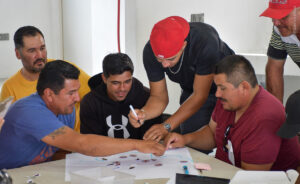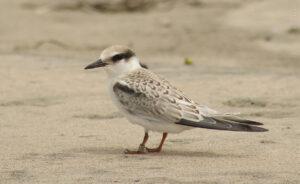At Pronatura Noroeste we are a key player in the international effort to conserve shorebirds on our continent.
Every winter, millions of shorebirds from North America arrive in Northwest Mexico in large flocks to escape the cold and to obtain shelter and food on our coasts and wetlands, which are characterized by a temperate climate. Numerous species take advantage of the resources of our region and continue their journey to Central and South America. This impressive migration, which impacts many regions and ecosystems, extends for more than 16,000 kilometers and is called the Pacific Migratory Route.
This is a phenomenon increasingly studied by experts, since to a large extent the migration of shorebirds on the Pacific coast serves as a great indicator of the health of ecosystems. Migratory species not only have to overcome a long journey that puts their survival to the test, but also face environmental threats, climate change, urban encroachment, and pollution in their temporary habitats. In fact, many of these species change their migratory pattern for these reasons and are at risk of disappearing to such an extent that in the last 50 years, 35% of migratory birds have disappeared worldwide.
Northwest Mexico is a transition zone on the Pacific Migratory Route. That is why at Pronatura Noroeste we collaborate in a multinational coordination alliance, known as the International Strategy for the Conservation of Shorebirds of the Pacific Route of the Americas. This collaborative action links national, state, and local governments, as well as environmental organizations for the monitoring, study, and protection of migratory birds throughout their journey.
By having a presence in the main wetlands and coasts of our region, at Pronatura Noroeste we generate solid and up-to-date information to restore and maintain the populations of migratory birds, which remain here for a few months and, in reality, belong not only to Mexico but to the whole continent.
One of the activities included in this strategy is the creation of narrative maps of bird migration. It consists of 28 projects associated with the conservation of migratory birds, organized into seven strategies, with a panel of metrics to measure the impact of each project and share its achievements.
As Pronatura Noroeste, we contributed two specific projects focused on the more than 250 species of migratory birds that pass through our region. In the first instance, we conducted a study of the effects of sea level rise on the habitat of coastal birds due to the fact that in the next century, the sea level will rise between 0.3 and 1.2 meters due to global warming. The study focuses on estimating the effects of this radical change on ecosystems and beaches.
The second project is participation in the network of MOTUS stations to monitor bird migration. This is the installation of antennas that detect specimens of birds that carry tiny transmitters (which do not affect their normal life since they are placed on one leg and do not exceed 1% of the weight of the animal). With the network of MOTUS stations, the time of arrival and departure of migratory flocks is recorded, as well as their route and the places they use to feed. We placed the first MOTUS station in our region in January 2021 in the Punta Banda estuary, south of Ensenada. By March 2022, we will have 14 stations, with the goal of completing a network of 24 MOTUS stations in the 15 coastal wetlands of the region.
These two projects are led by the coordinator of the MOTUS initiative at Pronatura Noroeste and a Doctoral candidate at the University of South Carolina, Julián García Walther.
To learn more about our bird conservation work and invest in this high-impact project.
















